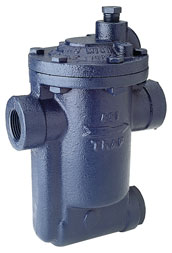

For pressures to 250 psig (17 bar) . . .
Capacities to 4,400 lb/hr (2000 kg/hr)
The most reliable steam trap known—the inverted bucket—provides efficient condensate drainage of virtually all types of steam-using equipment. Put the inverted bucket to work in a tough cast iron package, and you have the best of both worlds. Because they operate efficiently for longer periods of time, Armstrong cast iron inverted buckets add solid energy savings to lower replacement/labor costs. Armstrong cast iron inverted bucket traps are repairable for even bigger maintenance savings.
A unique leverage system multiplies the force provided by the bucket to open the valve against system pressure. The mechanism is free-floating and has no fixed pivots to create wear or friction.
Because the mechanism is located at the top of the trap, no dirt can collect on the orifice. Small particles of dirt are held in suspension until discharged by the full differential purging action when the bucket sinks, pulling the valve off the seat.
The discharge orifice is surrounded by a water seal, which prevents live steam loss. Automatic air venting is provided by a small vent hole in the bucket, which provides continuous automatic air and CO2 venting at steam temperature.
Inverted bucket traps drain continuously, although discharging intermittently, allowing no condensate backup. They are also resistant to water hammer.
For pressures to 250 psig (17 bar) . . .
Capacities to 4,400 lb/hr (2000 kg/hr)
The most reliable steam trap known—the inverted
bucket—provides efficient condensate drainage of virtually all types of
steam-using equipment. Put the inverted bucket to work in a tough cast
iron package, and you have the best of both worlds. Because they operate
efficiently for longer periods of time, Armstrong cast iron inverted
buckets add solid energy savings to lower replacement/labor costs.
Armstrong cast iron inverted bucket traps are repairable for even bigger
maintenance savings.
A unique leverage system multiplies the force
provided by the bucket to open the valve against system pressure. The
mechanism is free-floating and has no fixed pivots to create wear or
friction.
Because the mechanism is located at the top of
the trap, no dirt can collect on the orifice. Small particles of dirt
are held in suspension until discharged by the full differential purging
action when the bucket sinks, pulling the valve off the seat.
The discharge orifice is surrounded by a water
seal, which prevents live steam loss. Automatic air venting is provided
by a small vent hole in the bucket, which provides continuous automatic
air and CO2 venting at steam temperature.
Inverted bucket traps drain continuously,
although discharging intermittently, allowing no condensate backup. They
are also resistant to water hammer.
Submittal Drawing
No PDF available for download.
No PDF available for download.
No PDF available for download.
No PDF available for download.
No PDF available for download.
No PDF available for download.
Copyright © 2025 Campbell-Sevey, Inc.